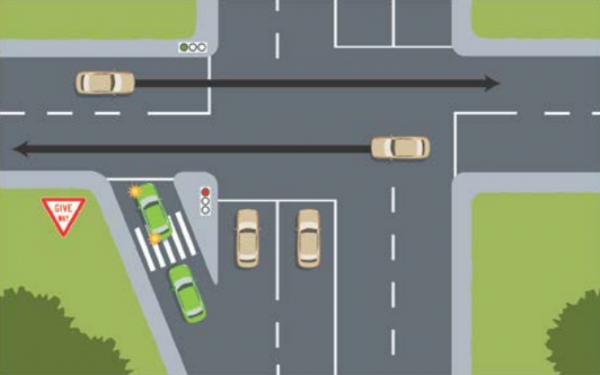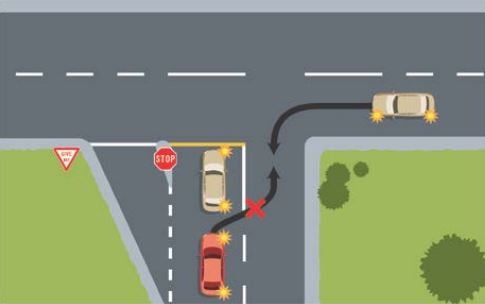There are two types of errors that could cause you to fail your restricted or full licence practical driving test:
- Critical errors – you can make one of these in stage 1 of the test and up to two critical errors in total for the whole test; any more and you automatically fail
- Immediate fail errors – if you make an immediate fail error the test will be called off immediately.
Critical errors
A critical error is a serious driving error that doesn’t create an immediate danger to other road users, property or you as the driver.
Examples of critical errors
- Speeding: if you drive at more than 5km/h over the speed limit, but less than 10km/h, for no more than 5 seconds you will get a critical error. The testing officer will take the reading from your speedometer.
- Driving too slow: if you are holding up other traffic because you are driving at 10km/h or more below the speed limit while the conditions are good, this is a critical error. If it’s raining heavily or the road is gravel or icy, then travelling slower is acceptable.
- Hesitation: this is usually caused by nervousness about gap selection, i.e. you have ample time to pull out into an intersection but you don’t go. It can also be caused by not paying attention when the lights go green or by not moving forward when vehicles ahead of you have moved.
- Unnecessary stopping: if you stop at a pedestrian crossing when there’s no one crossing or waiting to cross, or if you stop at a green light when the way is clear, this will get you a critical error. Don’t stop at a give way sign where you create an obstacle to other traffic.
- Not signalling: you must signal at least 3 seconds before you change lanes, move any more than a car’s width left or right, pull away from the kerb, cross the centre line and enter a roundabout (unless you are going straight ahead). Testing officers are looking for correct indication on the roundabout, so be sure you know the rules as this is a very common critical error. If the signal automatically cancels early you can reactivate it.
- Not looking: remember to check over your shoulder in your blind spots at relevant times. At intersections, you should take two looks in each direction to be sure there were no other road users in the blind spots created by the front pillars of your car. When moving away from the kerb, check over your shoulders. When changing lanes or partially changing lanes, check mirrors and blind spots. At railway crossings, slow down and look both ways. If you cause another road user to swerve or brake heavily this might result in an immediate fail error.
- Blocking: if you block a pedestrian crossing or intersection because you failed to see the traffic was stopping ahead of you, this will get you a critical error. Don’t stop blocking a driveway at the end of your test. The only time this doesn’t apply is if a pedestrian crossing is at an intersection and you need to stop there to see oncoming traffic if you are the first vehicle in the queue, but not the second vehicle in the queue.

- Not stopping: make sure you come to a complete stop at a stop sign. This is a critical error in the restricted test but an immediate error in the full licence test.
- Stalling: if you drive an automatic car this shouldn’t be a problem, but if you’re in a manual vehicle stalling it shows that you don’t have good car control. If you can’t restart the vehicle without intervention from the testing officer, an immediate fail will be recorded.
- Mounting the kerb: while you are parking or manoeuvring away from a parking space or performing a three-point turn you are allowed to gently touch the kerb (as long as it doesn’t cause discomfort to anyone in the car) but if you mount the kerb with one wheel then you’ll get a critical error; if two wheels mount the kerb or if other road users are in danger it’s an immediate fail error.
- Miscellaneous illegal actions: these are serious errors that don’t pose an immediate threat or danger. They include things like cutting corners (be careful especially when turning into intersections), turning into the wrong lane, following between 1-2 seconds behind the car in front, driving over traffic islands or roundabouts designed for heavy vehicles, not giving way to a pedestrian waiting at a crossing, driving partly on the wrong side of the road or in a special vehicle lane, turns from a lane marked for straight-through traffic only or drives straight through from a lane marked for turning only.
If any of the above create a dangerous situation then they may be considered as an immediate fail error.
Immediate fail errors
If your driving creates an immediate danger to other road users, property or yourself, or your testing officer has to intervene because you are not capable of driving by yourself, you will receive an immediate fail error which will end your test.
Examples of immediate fail errors
- Not stopping: failure to come to a complete stop at a red traffic light (or a yellow light if there is enough time to stop), at a stop sign (for the full licence test) and railway crossings when the lights are flashing and/or the barriers are down are considered immediate fail errors.
- Not giving way: this includes at intersections (e.g. pulling out in front of another vehicle or merging into its lane causing it to take evasive action), one-lane bridges, pedestrian crossings and any other place you need to give priority to another road user or pedestrian.
- Intervention: if the testing officer has to intervene by grabbing the steering wheel or activating the dual controls to stop you doing something dangerous, it’s an immediate fail.
- Collision: if you hit something – the kerb, another vehicle, a pedestrian or street furniture – and it is fully or partly your fault, you will immediately fail. If another driver runs into you and it is completely their fault, an exception is made; the problem might be, though, that you have to rebook your test if your vehicle is damaged.
- Not carrying out the testing officer’s instructions: if you don’t do what the testing officer says because you don’t have the confidence or ability, you will be failed. If you didn’t hear the testing officer correctly then this will not usually result in a fail; if you are unsure of any directions ask for them to be repeated. If you are not good with instructions for left or right, ensure the testing officer indicates the direction, too.
- Dangerous positions: stopping on a railway level crossing, on a hatched intersection, on a pedestrian crossing or somewhere else that is dangerous will result in an immediate fail, as will driving over part of a traffic island or roundabout that is not intended to be driven on.
- Speeding: exceeding the posted speed limit by more than 10km/h for any duration or exceeding the speed limit by between 5-10km/h for more than 5 seconds. Remember that the speed limit begins at the sign.
- Miscellaneous dangerous actions: anything that causes an immediate potential threat for other road users, for example, taking your eyes off the road for a dangerous amount of time, looking at your cellphone, overtaking on a solid yellow line, approaching an intersection in the wrong lane, speeding more than 10km/h over the limit, following another vehicle at less than 1 second behind, etc

Despite not being on the official list, using cruise control or a speed limiter could cause the examiner to fail you.

